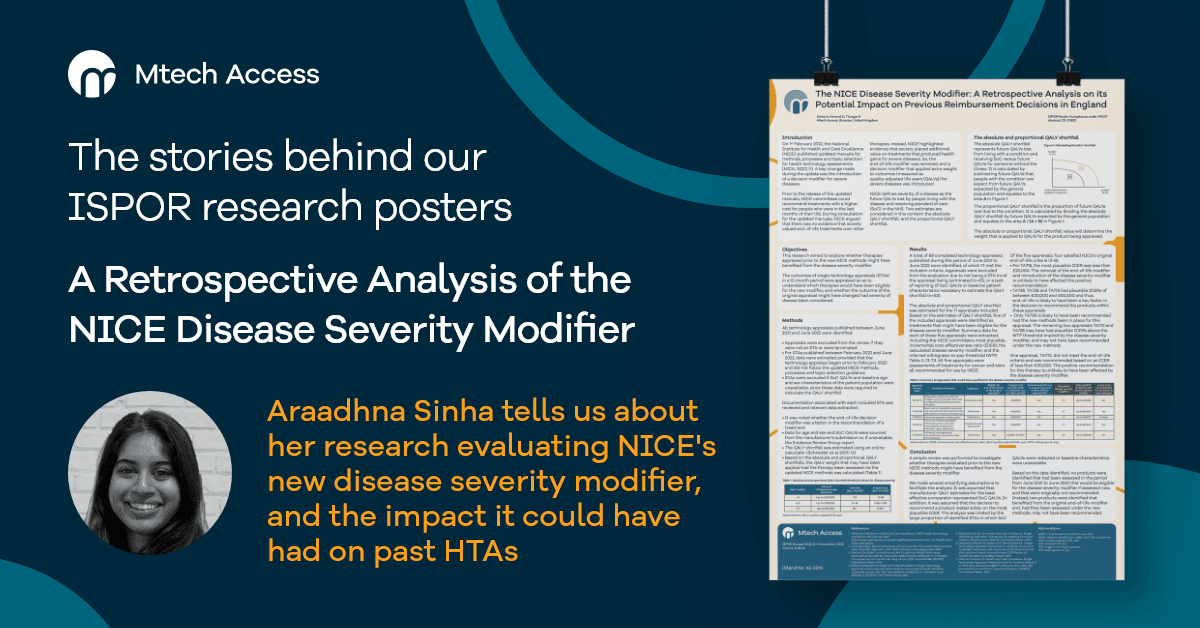
We speak to Araadhna Sinha (Associate Health Economist) to get the story behind the poster: ‘The NICE Disease Severity Modifier: A Retrospective Analysis on its Potential Impact on Previous Reimbursement Decisions in England’. Araadhna worked with Elizabeth Thurgar (Director – Health Economics) and Dan Howard (Principal Health Economist), to research, develop, and co-author the poster for presentation at ISPOR.
In all, we presented 7 independent research posters at ISPOR Europe, from 7th–9th November 2022. In this series of interviews we sit down with poster authors to learn a bit more about their research.

What topic does your poster explore?
On 1st February 2022, the National Institute for Health and Care Excellence (NICE) published updated manuals for methods, processes and topic selection for health technology assessments (HTAs). One of the changes made during this update was the replacement of the end-of-life decision modifier with a decision modifier that placed additional value on treatments that produced health gains for severe diseases.
Our poster explored whether treatments appraised by NICE prior to the introduction of the disease severity modifier might have received different recommendations had they been assessed under the updated methods.
What inspired you to pursue this topic?
I joined Mtech Access in November 2021 and, having not previously worked on a HTA, I’d had no interaction with NICE’s methods of evaluation. When the topic was proposed to me, it seemed like a good way to familiarise myself with HTAs at NICE and how the updated methods would affect my work in HTA at Mtech Access going forward.
How did you and your co-writers work together to conduct the research and develop the poster?
Dan ran searches to identify single technology appraisals (STAs) published between June 2021 and 2022 that had been developed using NICE methods from before February 2022.
Together, Dan and I reviewed the included appraisals and extracted the data needed to estimate a decision modifier for severity of disease. This included standard of care quality-adjusted life years (QALYs) and baseline demographic data. Using an online QALY shortfall calculator, I inputted the extracted data and calculated the absolute and proportional QALY shortfall, and the potential QALY weighting for disease severity.
Elizabeth provided strategic support throughout the research and development of our poster. She reviewed our research methods and provided advice on how to interpret our findings.
What was the most interesting aspect of your research?
I was interested to see the implied recommendations under NICE’s new methods. While two of the appraisals’ original most plausible ICERs were below NICE’s usual willingness-to-pay threshold of £30,000 per QALY; replacing the end-of-life criteria with the disease severity modifier would not have affected their positive recommendation.
However, three of the appraisals’ most plausible ICERs were between £30,000 and £50,000 per QALY, exceeding NICE’s usual willingness-to-pay threshold. The end-of-life criteria is likely to have been key in their recommendation. Yet, two of these appraisals’ most plausible ICER would have exceeded the willingness-to-pay threshold implied by the disease severity modifier. As such, their original positive recommendation may have been reversed under the new methods.
Were the results as you anticipated when you began your research? Were there any surprises?
I was somewhat surprised that all five appraisals that would have met the criteria for a disease severity modifier were for cancer treatments. Other severe diseases did not appear to meet the criteria for a disease severity modifier in our review.
What’s the next step for your research?
Going forward, I would like to explore appraisals further into the past to increase the number of qualifying appraisals that we could draw conclusions from. The appraisals that we reviewed were taken from a 12-month period. This only gave us 89 technology appraisal documents to review.
In addition, many of the appraisals we reviewed did not publish baseline patient characteristics or standard of care QALYs. So, we could not establish if they would have qualified for the modifier.
This led to a very limited data set. We could only evaluate recommendation decisions for five qualifying appraisals. The others in our time period either did not report these data, or did not qualify for a severity modifier.
As a result, we were unable to draw robust conclusions from our work as we had very few appraisals available to us to fully evaluate. The true impact of NICE’s new method could be explored in more depth if we could evaluate more appraisals.
What have you learnt that you can apply to future research?
I learnt the importance of thorough and systematic research through the process of developing the poster. It involved a careful evaluation of the 89 technology appraisal documents from NICE’s website to establish the applicability of the disease severity modifier. We had to pay very close attention to the details of those documents to pick up on the relevant information for our poster!
I also became much better acquainted with the process that manufacturers navigate to gain NICE recommendations for their products. STAs contain an abundance of documents detailing this process and I learnt how to navigate through these to identify the information I needed for this poster.
I think this new understanding will be of great help when working on future HTA submission projects, as I am now a lot more familiar with the process.
View the poster here.
If you would like to discuss this research with the poster authors or to learn more about how we can support you with health economic evaluation, health technology assessments and NICE reimbursement, email info@mtechaccess.co.uk.


